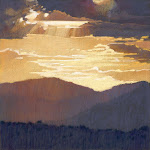Saturday was the opening of the Connecticut Pastel Society's annual national show "Renaissance in Pastel". This year it's at the Mattatuck Museum in Waterbury CT and is well worth the visit. The Renaissance Show is one of the highlights of the pastel year, with some of the best pastelists, and best emerging pastelists you will find anywhere. Trust me - see the show if you can. Through October 25.
My husband, Michael, drove down and back and all I had to do was to watch the sky. The foliage is somewhat dull this year, probably due to the rainy Spring. But the skies! Have you ever noticed that in the northeast the skies are the most interesting in October and especially November. The steeper angle of the sun causes more dramatic lighting throughout the day. I shot several cloud formations as we drove and here are some of my observations:
• Have you ever noticed that sometimes clouds at the horizon are not only the same blue but the same value as the sky holes higher up, yet you know that you are looking at clouds below and sky above. Weirds me out. How do you paint that!

• The following image illustrates an important concept of painting skies. Regardless of what the clouds look like you need to make sure that the sky underneath the clouds transitions from lighter at the horizon to darker above, gradually, smoothly, and consistently. If it doesn't then your clouds will float in ambiguous space and the impression of distance will be destroyed.
 • Some cloud shapes are not conducive to painting - they look too bizarre, like a broken baguette or hovering spacecraft - however they can be intriguing to look at:
• Some cloud shapes are not conducive to painting - they look too bizarre, like a broken baguette or hovering spacecraft - however they can be intriguing to look at:


Here's to looking!




No comments:
Post a Comment